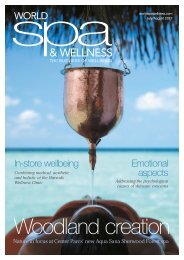Better Nutrition August 2017
Create successful ePaper yourself
Turn your PDF publications into a flip-book with our unique Google optimized e-Paper software.
like to do more than just prevent rickets or<br />
beriberi; we would like to experience vitality<br />
and health. But just as important, you’ll<br />
want to make sure that you aren’t taking<br />
too much of any particular ingredient or<br />
nutrient. You must take into account your<br />
age, gender, diet, and a host of other factors.<br />
The daily value (DV) is a percentage,<br />
calculated on the average recommended<br />
daily allowance (RDA) for adults. For each<br />
nutrient, there is only one DV for everyone<br />
4 years of age or older. That means<br />
the DV does not distinguish between the<br />
nutritional needs of an 80-year-old man, a<br />
29-year-old woman, or a 6-year-old child.<br />
Be aware that your RDA might be higher<br />
or lower than the DV. For example, the DV<br />
for vitamin D is 400 IU, whereas the RDA<br />
for anyone from 12 months to 70 years of<br />
age is 600 IU—and 800 IU if you’re over<br />
the age of 70. All vitamins will list 400<br />
IU as 100 percent of the DV; however, just<br />
as an example of how general the DV is,<br />
a 75-year-old man would actually need<br />
double that amount.<br />
What you won’t find on labels is information<br />
about the upper limit (UL), which<br />
is the tolerable upper intake level for a<br />
given nutrient. In other words, the UL is<br />
the highest daily intake of a nutrient<br />
unlikely to pose a risk of adverse health<br />
effects to most people, as determined by<br />
the Food and <strong>Nutrition</strong> Board. The UL<br />
represents total intake of a vitamin or<br />
mineral from food, beverages, and supplements,<br />
and differs for infants, children,<br />
teenagers, men, and women of all ages, as<br />
well as pregnant and nursing women. For<br />
a chart detailing the upper intake levels<br />
of vitamins and minerals, visit The<br />
National Institutes of Health website<br />
(nih.gov), or refer to my book,<br />
Fortify Your Life.<br />
Q: Supplements come in so many<br />
forms—tablets, capsules, softgels,<br />
chewables, lozenges, powders,<br />
liquids—is there one that’s best?<br />
Dr. Low Dog: There are advantages and<br />
disadvantages of each.<br />
Tablets: They’re cost-effective, shelf-stable,<br />
and have longer expiration dates. If you<br />
have a healthy digestive tract and aren’t<br />
taking medications such as proton pump<br />
inhibitors (Nexium, Prilosec) that shut off<br />
production of stomach acid, your digestive<br />
system shouldn’t have any problem breaking<br />
down a supplement tablet made by a<br />
reputable manufacturer. One downside:<br />
Tablets can be difficult to swallow, but<br />
this can be easily remedied by using a pill<br />
slicer to cut your tablets in half.<br />
Capsules: They’re easy to swallow and<br />
break down quickly. You can also open<br />
capsules and put the ingredients into a<br />
smoothie, applesauce, or yogurt, making<br />
capsules an attractive option for children<br />
or those who have difficulty swallowing.<br />
Vegetarians/vegans take note: Although<br />
most supplement manufacturers use<br />
capsules made from vegetable material<br />
Chewables are one of the<br />
fastest-growing and most<br />
popular categories of dietary<br />
supplements.<br />
(veggie caps), some may contain gelatin<br />
derived from animals. Check the labels.<br />
Softgels: These smooth, one-piece<br />
capsules are designed to hold liquid or<br />
oil-based preparations, such as vitamin<br />
E or fish oil. They’re easy to swallow<br />
and, because they’re airtight, offer a<br />
long shelf life. Unlike capsules, they’re<br />
currently made almost exclusively from<br />
gelatin from animal sources, so they<br />
aren’t suitable for vegetarians or vegans.<br />
Chewables: If you like to take your supplements<br />
in the form of gummy bears, don’t<br />
be embarrassed. You aren’t the only one!<br />
Chewables are one of the fastest-growing<br />
and most popular categories of dietary<br />
supplements. Most contain some form of<br />
sweetener and/or flavoring, which could<br />
be either natural or artificial—so read<br />
labels closely. And vegans and those sensitive<br />
to dairy should be aware that some<br />
chewable supplements contain lactic acid,<br />
which may have been derived from dairy.<br />
Lozenges: Designed to dissolve slowly in<br />
the mouth, lozenges are usually used<br />
to soothe a cough or sore throat. Some<br />
supplements are available in lozenge form<br />
as an alternative to chewables.<br />
Be aware that they<br />
may contain some type of<br />
sweetener as well as flavorings<br />
or colorings. Keep<br />
them away from young<br />
children who may confuse<br />
them with candy.<br />
Powders: Powders are useful when<br />
you want to use larger amounts of a<br />
supplement. For example, the amount of<br />
inositol used for anxiety or sleep is typically<br />
6–12 grams, or 2–4 teaspoons. That would<br />
be 12–24 capsules per day! Powders<br />
can be added to smoothies and food,<br />
and have a decent shelf life. But they<br />
are less convenient when traveling<br />
or on the go.<br />
Liquids: Some liquid vitamins and minerals<br />
are available in a sublingual form,<br />
drops that are placed under the tongue<br />
48 • AUGUST <strong>2017</strong>






